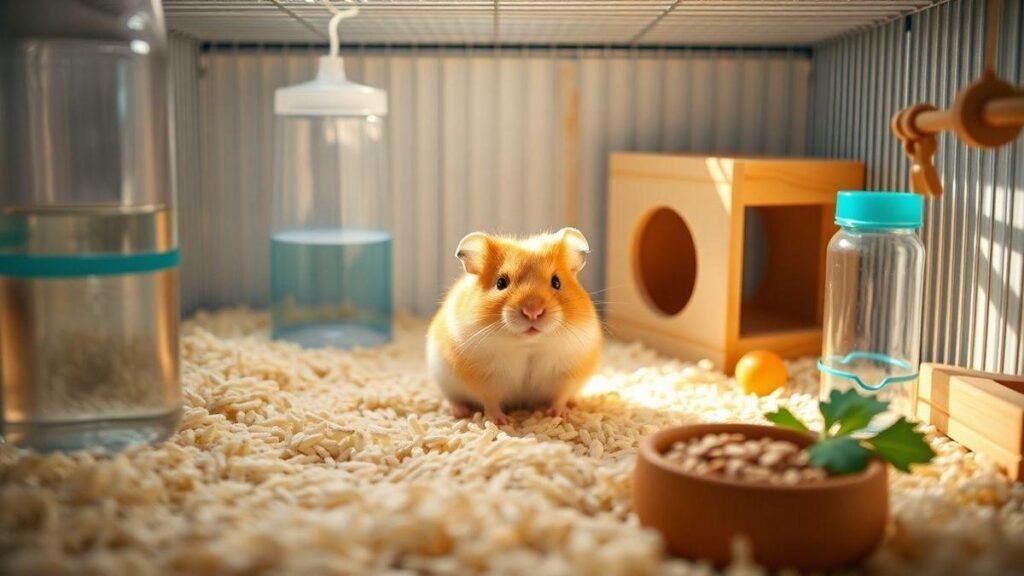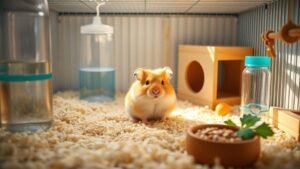Como criar hamster em gaiola adequada para a saúde dele — A practical, experience-based guide
I write from experience about how to create a cage that protects your hamster’s health. This guide covers choosing the right floor area, safe bedding, gentle ventilation, a steady cleaning routine, proper enrichment, and non-toxic materials. Follow these steps to apply “Como criar hamster em gaiola adequada para a saúde dele” in practice, and consider how creating a pet-friendly indoor space will help keep conditions stable.
Key takeaway
- Choose a roomy cage with a solid floor.
- Use soft, low-dust bedding and replace it regularly.
- Provide two or more hideouts and safe tunnels.
- Fit a solid-surface wheel sized to prevent back arching.
- Spot-clean daily, deep-clean regularly, and monitor behavior.
Cage size: match species needs and give running room
I start by matching cage size to the hamster’s species. A cramped hamster shows short, repetitive runs and reduced activity; if you notice stress signals, review basic care principles in this practical care guide.
| Species | Minimum floor area | Minimum height | Why it matters |
|---|---|---|---|
| Syrian | 450 sq in (≈ 2900 cm²) | 30 cm | Room for a large wheel and lower stress |
| Dwarf | 360 sq in (≈ 2320 cm²) | 25–30 cm | Smaller but still needs running space |
- Prefer solid floors over wire.
- Avoid excessively tall, narrow cages — hamsters need floor space more than height.
- Check bar spacing: ≤ 1 cm for dwarfs, ≤ 1.5 cm for Syrians.
- Platforms are fine if they add usable floor area.
Como criar hamster em gaiola adequada para a saúde dele: tunnels, hideouts and layout
When arranging tunnels and shelters, prioritize comfort and safety.
- Tunnel width: 6–8 cm for Syrians; 4–6 cm for dwarfs.
- Provide 2 hideouts so the hamster can choose a quiet spot.
- Use natural bedding in a snug nesting box; avoid thin plastic tubes that trap scent and are hard to clean.
- Rotate toys and hides to keep the environment interesting — see advice on introducing new toys and enrichment.
Quick layout checklist:
- Place hideouts at floor level.
- Wash plastic parts weekly.
- Keep a long running tunnel if space allows.
Bedding: protect lungs, enable digging
Choose bedding that is absorbent, low-dust, and safe for burrowing.
| Hamster type | Bedding depth I use | Full replacement |
|---|---|---|
| Syrian | 8–15 cm | Every 1–2 weeks |
| Dwarf | 5–10 cm | Every 1–2 weeks |
| Spot cleaning | — | Daily (remove wet spots) |
Safe bedding options:
- Paper-based (fluffy or pellets) — low dust, absorbent.
- Aspen shavings — low oil, natural.
- Hemp — highly absorbent, low dust.
Avoid:
- Cedar and pine (strong oils), scented bedding, cotton balls, and clumping cat litter.
If you spot sneezing or fast breathing, change bedding immediately and consult a professional; for broader pet-care context see how to evaluate your pet’s care.
Ventilation and materials: fresh air without drafts
Good airflow is essential, but avoid direct cold drafts.
- Place the cage away from windows and vents; keep room temperature around 20–24°C (68–75°F).
- Use a wire top with a solid base for ventilation while blocking drafts.
- Prefer metal bars, thick acrylic bases, and untreated hardwood for toys/hideouts.
- Read labels: choose non-toxic, phthalate-free, dust-free products.
Quick checks:
- Top ventilation: wire lid with close bar spacing.
- Side airflow: avoid sealed tubs without vents.
- Drafts: move cage away from sources of wind.
For tips on arranging your home to suit small pets, the guide on pet-friendly indoor spaces is helpful.
Cleaning routine: prevent illness with simple regular care
A consistent cleaning schedule is central to “Como criar hamster em gaiola adequada para a saúde dele”.
- Spot-clean daily: remove wet bedding, spoiled food, and droppings.
- Partial clean weekly: replace ~50% bedding, wash food bowls.
- Full clean monthly: replace all bedding and sanitize cage parts.
I use mild unscented soap or a 1:10 white vinegar solution, rinse items thoroughly (three times if soap used), and dry completely before returning bedding. Avoid bleach and scented sprays.
Step-by-step:
- Move hamster to a secure carrier with familiar toys.
- Remove all bedding and items.
- Wash hard items with mild soap or vinegar solution.
- Rinse well and dry fully.
- Replace with fresh, dust-free bedding and return hamster.
Keep cleaning low-stress and safe by following routines in clean-home strategies for pet owners and by reviewing safety tips for cleaning around pets.
Enrichment and wheel safety
Rotate enrichment to keep your hamster curious and active.
- Rotate 1–2 toys every 3–7 days.
- Offer chew toys, tunnels, hideouts, and foraging games (hide small treats).
- Use a solid-surface wheel (plastic or solid metal). Wire wheels can injure feet and tails.
- Wheel sizes: 28–30 cm for Syrians; 20–24 cm for dwarfs — confirm the hamster’s back remains straight while running.
Enrichment checklist:
- Toy rotation: every 3–7 days — see suggestions on introducing new enrichment activities.
- Wheel check: ensure straight back while running (monthly).
- Clean wheel weekly.
Establishing a predictable daily pattern also helps activity and welfare — adapt ideas from daily routine planning.
Hazards and DIY: build safe, non-toxic cages
Inspect cages weekly for gaps, sharp edges, loose paint, and unstable parts.
Common fixes:
- Seal gaps > 0.8 cm for dwarfs, > 1 cm for larger types.
- Sand sharp edges and countersink screws.
- Strip flaking paint and refinish with pet-safe, water-based paint; cure for 48–72 hours before use.
DIY material choices:
- Untreated plywood (sand edges smooth).
- Hardware cloth (small mesh 1/8″–1/4″).
- Stainless screws & bolts.
- Non-toxic, water-based paint (cure before use).
DIY build plan highlights:
- Measure carefully; build a solid base.
- Attach mesh securely and air out the finished cage.
- Test with a stuffed toy before introducing your hamster.
Regular inspections and a care-first mindset are part of responsible pet ownership.
Conclusion
To follow “Como criar hamster em gaiola adequada para a saúde dele”, focus on four pillars: room to run, low-dust bedding, gentle ventilation without drafts, and a steady cleaning routine. Use non-toxic materials, provide proper wheel and hideouts, rotate enrichment, and inspect for hazards regularly. Small changes (e.g., switching dusty shavings for paper bedding) can greatly improve your hamster’s health and behavior. For related topics like nutrition and daily care, see resources on vitamin-rich foods for pet rodents and overall pet care guidance.
Frequently asked questions
Q: What size cage does my hamster need?
A: Aim for at least 450 sq in for Syrians and 360 sq in for dwarfs; a practical guideline is roughly 80 x 50 cm for a comfortable setup.
Q: What bedding should I use?
A: Choose paper-based or hemp bedding that is low-dust and absorbent. Avoid cedar, pine, scented options, and loose cotton.
Q: How often should I clean the cage?
A: Spot-clean daily, do a partial/weekly refresh, and a full monthly wash. Maintain the routine recommended in “Como criar hamster em gaiola adequada para a saúde dele”.
Q: What toys and enrichment should I add?
A: Provide a solid-surface wheel, chew toys, tunnels, and hideouts; rotate items to prevent boredom. See methods for introducing new enrichment.
Q: How do I set up food and water?
A: Use a heavy food bowl and a clean water bottle. Check water twice daily and balance pellets with occasional fresh vegetables and small treats — for nutritional guidance consult rodent nutrition tips.
For more practical tips and real-life fixes about “Como criar hamster em gaiola adequada para a saúde dele”, visit this pet care resource.






